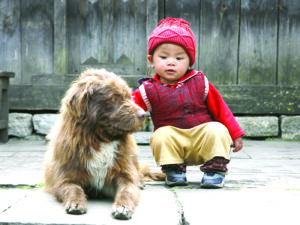By Dr. Beth Leermakers
“Teach your children well.” This song title applies to teaching kids how to interact safely and respectfully with pets. I cringe when I see those “cute” photos of toddlers lying on top of the family dog. There’s nothing cute about that scenario. Even the best-mannered, most tolerant dog may eventually say “enough is enough” and defend himself by snapping or biting the child. And then the dog is labeled “aggressive.”

Photo courtesy of Texas A&M College of Veterinary Medicine
We should not expect dogs and cats to know how to interact with children — or to tolerate having their ears or tail pulled. Parents need to supervise their children closely and teach them how to treat the dog, cat or any other family pet.
Before you introduce your new cat or dog to your kids:
Get to know your new pet. Notice whether your new cat or dog gets startled by sudden noise or movements. Does she have any areas where she prefers to be petted — or any sensitive areas that should not be touched? Model appropriate, positive interactions with your new companion; children will follow your lead.
Create a pet voice. You and your children should use a quiet, soothing, sing-song voice when talking to your cat or dog. Children, especially young ones, tend to speak loudly and may frighten your pet. Tell children how to handle pets. Explain to your kids (and remind them frequently) that pets do not like having their tails, ears and hair pulled. Hugging or sitting on the dog is not ok (many dogs do not like being hugged). They should hold small animals (kittens, guinea pigs, rabbits) with two hands, not one, for the pets’ safety and comfort.
Let the pet choose whether to interact with your child. Put your new furry friend in a safe, secure room with a door. Supervised by you, your child should start by spending short periods of time interacting with your pet in that room, gradually staying longer. When you enter the room, you and your child should calmly greet the cat or dog using your pet voice.
Let your new pet approach your child — not vice versa. People should only pet cats and dogs when they want to be petted. Teach your child not to reach for the cat or dog or make the first move.
Have your child sit on the floor (so she’s not towering over the pet), and wait for your new pet to come to your child. If your pet doesn’t approach your child, teach your child to respect that boundary and not force your puppy to interact. Children may be too rough when they touch a cat or dog, so you’ll need to show them how to be gentle. Remind children (again!) that animals do not like having their ears, tail or hair pulled.
Let the cat or dog (or small animal) smell your child’s hand before she pets them. This allows the furry critter to become familiar with the smells they’ll be exposed to.
Use gentle strokes (not patting or thumping), moving your hand in the same direction as your pet’s fur (head to tail). Cats tend to like being petted on their back, shoulder, neck and head. The paws, belly and tail are off limits.
Dogs like being petted on their back and chest. After they feel comfortable, they may enjoy belly rubs. Teach your child how to tell whether a cat or dog wants to be touched.
Purring can be a sign of happiness — or fear or stress. If your cat is purring, but his tail is swishing back and forth really fast, it’s time to leave the kitty alone.
If your dog growls or snaps, he’s telling you he wants to be left alone. Growling and snapping are warning signs. If you don’t back off, the dog may escalate to biting.
If your dog’s tail is tucked between his legs, or the hair on his back is standing up (hackles are raised), he’s scared, nervous or uncomfortable. Young children may not be able to detect these subtle signs, so parents must supervise all interactions.
If your dog leans into you or nudges your hand, it’s ok to pet her.
Roughhousing, kids and pets are a recipe for disaster. Cats and dogs may be fearful or over-excited when kids run through the house, jump from the couch or bed and/or throw toys. You may want to designate a playroom with a door or gate, so kids’ loud or rough play doesn’t stress out the family pets.
Teach your kids not to play roughly with your cat or dog. Children should not use their fingers or hands as cat toys. If they do, cats learn that it’s ok to use their claws and teeth on hands (or other skin), and that could lead to accidental injury to your child. Kids should not wave sticks or other objects at cats or dogs. An animal that feels threatened may defend himself and hurt your child.
Purchase appropriate chew toys for dogs — and cat trees and scratchers for cats — so they don’t destroy your child’s favorite stuffed animal or action figure.
Include your kids in interactive play with your pet. Have your child help you hold the fishing pole cat toy (to keep little fingers at a safe distance from sharp claws). Show your child how to safely play fetch. Kids shouldn’t try to pull a ball or other toy out of a dog’s mouth, which may lead to an accidental bite as the dog grabs the toy. The child should wait until the dog drops the ball, or trade the dog a treat (placed on the ground) for the toy.
Teaching your child how to interact appropriately with your pets will help keep everyone safe and happy.
